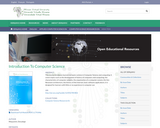
IT Fundamentals introduces computer hardware, computer software, databases, networking, security, and software development.
This course comprises 15 lessons covering IT fundamentals. Each lesson includes a combination of Wikipedia readings, YouTube videos, and hands-on learning activities. The course also assists learners in preparing for CompTIA IT Fundamentals certification.
Current Lessons
Current lessons targeting IT Fundamentals exam FC0-U61:
Introduction
Devices
Components
Peripherals
Operating Systems
Applications
Database Concepts
Database Use
Networking
Internet
Security Concepts
Security Practices
Software Development
Troubleshooting
Business Continuity
Previous Lessons
Previous lessons targeting IT Fundamentals exam FC0-U51:
Hardware
Peripherals
Operating Systems
Virtualization
Installation and Configuration
Applications
File Systems
File Management
Scripting
Networking
Internetworking
Security
Safety
Support
Mobile Devices
- Subject:
- Applied Science
- Computer Science
- Material Type:
- Full Course
- Date Added:
- 06/22/2020












